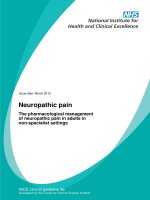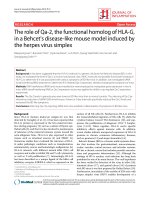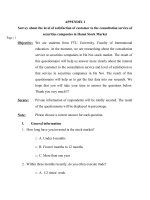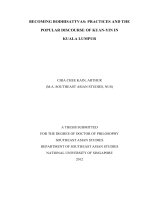The role change of Na+ ions in sodium silicate system under compression
Bạn đang xem bản rút gọn của tài liệu. Xem và tải ngay bản đầy đủ của tài liệu tại đây (465.02 KB, 8 trang )
HNUE JOURNAL OF SCIENCE
DOI: 10.18173/2354-1059.2019-0034
Natural Sciences, 2019, Volume 64, Issue 6, pp. 85-92
This paper is available online at
THE ROLE-CHANGE OF Na+ IONS IN SODIUM SILICATE SYSTEM
UNDER COMPRESSION
Mai Thi Lan, Nguyen Van Hong, Nguyen Thu Nhan
and Nguyen Thi Thanh Ha
School of Engineering Physics, Hanoi University of Science and Technology
Abstract. Structural properties of Na2O-9SiO2 liquid under compression are
studied by computer simulation. The local structure characteristics as well as
topology of SiOx are investigated via pair radial distribution function, coordination
number, Si-O bond distance and O-Si-O bond angle distribution. The incorporation
mechanism of Na+ ions in Si-O network as well as their role in network structure
will be clarified. Specially, influence of Na+ ions to the topology of SiOx units will
be explained in detail.
Keywords: High pressure, structural dynamics, transition.
1. Introduction
Alkali-silicate systems are the typical group of multicomponent oxide glasses with
tetrahedral network structure (SiO4). The structure of Alkali-silicate glasses and melts is
more than often centered on their cationic constituents and oxygen ions determine their
connectivity, directly impacting the physical properties of the material system.
Therefore, their structural properties have been extensively studied for a long time by
both experimental measure and computer simulation [1-7]. Namely, in works [5, 6], by
the X-ray diffraction, Warren and co-workers have shown the evidence of the
continuous random network (CRN) of Zacharaisen [7], which has been accepted as the
structural model of these glasses for many decades. X-ray and neutron diffraction
studies in works [8-10] provided more detailed structure features of sodium silicate
glasses. By neutron diffraction, it shown that Si-O bond distance increases with sodium
content. In work [11-14], it showed that the O-Si-O and Si-O-Si bond angle
distributions have the peak at around 109 and 144o respectively. An addition of sodium
into silica glass causes breaking the Si-O-Si linkage in CRN of silica forming nonbridging oxygen (NBO) and the sodium atoms tend to incorporate in silica network via
NBO. By X-ray absorption fine-structure spectroscopy (XAFS) [15-18], authors have
Received February 12, 2019. Revised June 3, 2019. Accepted June 10, 2019
Contact Mai Thi Lan, email address:
85
Mai Thi Lan, Nguyen Van Hong, Nguyen Thu Nhan and Nguyen Thi Thanh Ha
shown more detailed structural information around sodium ions. Namely, the Na-O and
Na-Si bond distance are around 2.30 and 3.80 Å respectively and it is almost not
dependent on the sodium content. However, the Na-O and Na-Si coordination number
are significantly dependent on the sodium content. Specially, the local environment of
sodium is very similar to those of their crystalline counterparts [15, 16]. Based on the
experimental data in works [15-17], Greaves and co-workers proposed the modified
random network model (MRN), they also suggested that sodium and NBO segregate
rather than being randomly distributed in the Si-O network. So, it formed sodium-rich
regions and silica-rich regions [16]. Besides, Qn distribution (SiO4 with n BO) were
investigated by NMR experiment [19-22]. It has been shown that Q3 species is dominant
for the sodium disilicate systems, and similar results were shown by Raman
spectroscopy [21, 23]. Although the structure of sodium silicate systems has been
studied extensively for a long time, their medium range structure is still an open
question. Besides, distribution of modifier in these glasses is also not be clarified. So, it
is necessary to have more experiment and simulation studies to clarify the above
problems.
With the development of technology information both hardware and software, the
computer simulation becomes a useful tool to clarify the structure of glassy system
(disordered materials). Molecular dynamics (MD) simulation are the most common and
widely used computer simulations techniques to study structural and dynamical
properties of disordered materials systems.
By MD simulation [24-31], authors have shown the clustered modifier regions. In
works [32, 33], the distribution of ring size in both silica and sodium silicates systems
has also been reported. However, detailed medium structure information of sodium
silicate glasses under compression is still in debate.
In this work, the structural characteristics and network structure of sodium silicate
(Na2O-9SiO2, denote as NS9) under a wide pressure range will be presented in detail.
The incorporation mechanism of Na+ ions in Si-O network as well as their role in
network structure will be investigated. Specially, influence of Na+ ions on the topology
of SiOx units will be discussed in detail.
2. Content
2.1. Calculation method
Molecular Dynamics simulation is conducted for sodium silicates system (Na2O9SiO2, 3000 atoms) at temperatures of 3500 K and 0-60 GPa pressure range. The Morse
potentials are applied in this work. This is empirical potential model developed for
application with multicomponent silicate glasses. The potential equation consists of a
long-range Coulomb potential, a short-range Morse potential and an additional repulsive
term. The detail of potential parameters can be referred in the work [2]. The size of
model is very small in comparison to real sample. Thus, its surface effect is very
significant. To eliminate the surface effect, the periodic boundary condition is applied
for all three dimensions.
86
The role-change of Na+ ions in sodium silicate system under compression
The simulation program was written in C language that can be applied for
simulation of silicate glasses and melts. In this study, the program is applied for
simulation of NS9. Calculation is performed on High performance computing system at
RIKEN institute in Japan with MD step of 0.5 fs. This value assures the requirement to
accurately integrate the Newtonian equations of motion in order to track atomic
trajectories and the computational cost is reasonable. Initial configuration is generated
by randomly placing all atoms in a simulation cell. To eliminate the memory effect of
initial configuration, the model is equilibrated at temperature of 6000 K for a long time
(about 105 time-steps). Next, this model is compressed to different pressure (from 0 to
60 GPa) and relaxed for about 106 MD steps. After that the models at different pressures
are cooled down to the desired temperature of 3500K with the rate of about 1012 K/s. A
consequent long relaxation (about 106 MD steps) has been done in the NPT ensemble
(constant temperature and pressure) to obtain equilibrium state.
In order to improve the statistics, the measured quantities such as the coordination
number, partial radial distribution function as well as distribution of bond angle, bond
length, NBOs, BOs are computed by averaging over 500 configurations separated by 20
MD steps.
2.2. Results and discussion
Firstly, to assure the reliability, the basic structural characteristic is investigated and
compared with experimental data. Figure 1 shows the radial distribution function of SiO, Na-O, O-O, Si-Si, Na-Na atomic pairs. Result in figure 1 reveals that the bond
distances of Si-O, Na-O, O-O and Si-Si pairs are 1.62, 2.34, 2.62, and 3.10 Å
respectively, which is in good agreement with experimental values as well as simulation
result in works [1-4, 6, 8, 10]. It also shows that, under 0-60GPa pressure range, the SiO bond distance is almost not dependent on pressure. However, the Si-Si and O-O bond
distance is significantly dependent on pressure. The Na-O, Na-Si and Na-Na bond
distance is strongly dependent on pressure. Figure 2 displays the Si-O coordination
number distribution. It can be seen that, at ambient pressure, most of Si atoms are
fourfold coordinated (around 90%), forming SiO4 units. The number of Si atoms with
five-fold coordination is about 5%. It also exists about 5% SiO3 units (because the
fraction SiO3 only exits at ambient pressure, so it is not presented in figure 2). There is
no SiO6 unit at ambient pressure. The average Si-O coordination number is around 4.0
at ambient pressure, see the figure 2 (left). This result is in good agreement with the
experiments and simulation in [1-4, 6, 8, 19].
As pressure increases, the fraction of SiO4 decrease strongly meanwhile the fraction
of SiO5 and SiO6 increases. The fraction of SiO5 get maximum value at around 40 GPa
and then decreased slightly with pressure. At pressure 60 GPa, the fraction of SiO 4,
SiO5 and SiO6 is around 10%, 40% and 50% respectively.
87
Mai Thi Lan, Nguyen Van Hong, Nguyen Thu Nhan and Nguyen Thi Thanh Ha
3
9
Si-Si
Si-O
0 GPa
20 GPa
40 GPa
2
0 GPa
20 GPa
40 GPa
6
1
3
0
0
3
0 GPa
20 GPa
40 GPa
O-O
g(r)
g(r)
2
0 GPa
20 GPa
40 GPa
Na-Si
2
1
1
0
0
A
2
0 GPa
20 GPa
40 GPa
Na-O
1
0 GPa
20 GPa
40 GPa
Na-Na
2
1
0
0
0
2
4
6
8
0
2
4
r(Å)
6
8
r(Å)
Figure 1. The radial distribution function of atomic pairs in NS9 systems
at different pressure and at 3500K
100
10
SiO4
Running coordination number,ZSi-O
SiO5
80
Fraction (%))
SiO6
60
40
20
0
0 GPa
20 GPa
40 GPa
8
6
4
2
0
0
10
20
30
P (GPa)
40
50
60
1
2
3
4
r(Å)
Figure 2. The Si-O coordination number distribution as a function of pressure (left);
running coordination number (right)
88
The role-change of Na+ ions in sodium silicate system under compression
Fraction
SiO5
SiO4
0.15
SiO6
0 GPa
5 GPa
10 GPa
15 GPa
20 GPa
25 GPa
30 GPa
40 GPa
60 GPa
0.10
0.05
0.00
40
80
120
160
40
80
120
160
40
80
120
160
Bond angle distribution (degree)
Figure 3. The O-Si-O bond angle distribution in SiOx (x = 4, 5, 6) of NS9 systems
at different pressures
SiO4
Fraction
0.06
0 GPa
5GPa
10 GPa
15 GPa
20 GPa
25 GPa
30 GPa
40 GPa
60 GPa
SiO5
0.04
SiO6
0.02
0.00
1.2
1.6
2.0
1.2
1.6
2.0
1.2
1.6
2.0
Bond length distribution (Å)
Figure 4. The Si-O bond distance distribution in SiOx (x = 4, 5, 6) of NS9 systems
at different pressures
Now we will focus on investigating the topology of SiOx units and clarifying the
influence of Na+ ions to the network structure as well as topology of SiOx units. Figure 3
shows the O-Si-O bond angle distribution (BAD) in SiOx units. It can be seen that in the
considered pressure range, O-Si-O BAD is almost not dependent on pressure. The O-SiO BAD in SiO4 has the peak at around 105-108o; the O-Si-O BAD in SiO5 has a main
peak at around 85-90o and a shoulder at around 160o; meanwhile the O-Si-O BAD in
SiO6 has one main peak and a small one at around 85-90o and 160-165o respectively. It
can be seen that O-Si-O BAD in SiOx of NS9 system is similar the ones in SiOx units of
silica system. This reveals that the Na+ ions in NS9 system does not affect to the O-Si-O
BAD in SiOx. Figure 4 shows the Si-O bond distance distribution (BDD) in SiOx at
different pressures. It can be seen that, the Si-O BDD in SiO4 is almost not dependent
on pressure. However, the Si-O BDD in SiO5 and SiO6 is slightly dependent on
pressure. The peak of Si-O BDD in SiO5 and SiO6 tend to shift to the left with the
increase of pressure. It reveals that average Si-O bond distance in SiO5 and SiO6
89
Mai Thi Lan, Nguyen Van Hong, Nguyen Thu Nhan and Nguyen Thi Thanh Ha
decreases slightly with pressure. The above analysis demonstrates the topology of SiO4
is almost not dependent on pressure and is not affected by Na+ ions. Meanwhile the
topology of SiO5 and SiO6 is changed slightly with pressure. In the previous works [34,
35], it has shown that the topology of SiOx (x = 4, 5, 6) in silica system is not dependent
on pressure. This reveals that, the Si-O BBD or in other word the topology of SiO5 and
SiO6 changed under compression is due to the present of Na+ ions. Therefore, topology
of SiO4 units is not affected by Na+ ions. This can be explained as follows:
At ambient pressure, most of SiOx units are SiO4 (90%) and the number of nonbridging oxygen (NBO) and bridging oxygen (BO) is about 13% and 87% respectively,
see Figure 5. One part of Na+ ions tends to be close to NBO, in this case they have the
role of network modifier ions; the remain part of Na+ ions tends to be close to SiO5, in
this case they have role of charge balance (at ambient pressure, the fraction of SiO 5 is
about 5%). Besides, because the number of Na+ in NS9 system is very small in
comparison to the number SiO4, the topology of SiO4 is not affected by the present of
Na+ ions. (Note: Na+ ions have positive charge, meanwhile NBO, SiO5 and SiO6 units
have negative charge, from now denote as [NBO]-, [SiO5]-, [SiO6]-).
1.0
Fraction
0.8
NBO
BO
0.6
0.4
0.2
0.0
0
10
20
30
40
50
60
P (GPa)
Figure 5. Distribution of BO and NBO in NS9 systems as a function of pressure
At high pressure, most of SiOx units are [SiO5]- and [SiO6]- and there is no [NBO]-.
Therefore, the Na+ ions tend to be close to [SiO5]- and [SiO6]- and they cause the
decrease of Si-O bond distance in SiO5 and SiO6 units. This can be explained as
following: the O-Si-O bond angle in the [SiO5]- and [SiO6]- units is smaller than the one
in SiO4. So, the distance between O2- and O2- ions decreases and the repulsion coulomb
force between them increases. It results in increasing the Si-O bond length in
comparison to the one in SiO4. When Na+ ions locate near [SiO5]- and [SiO6]-, the
repulsion coulomb force between O2- and O2- ions decreases leading to decrease of
some Si-O bond distances in [SiO5]- and [SiO6]-. This leads to the change of topology of
[SiO5]- and [SiO6]- units. In this case, all Na+ ions have the role of charge balance.
90
The role-change of Na+ ions in sodium silicate system under compression
In previous works [36, 37], it showed that, the SiO4, SiO5 and SiO6 were not
distributed uniform but forming separated clusters (SiO5-clusters, SiO5-clusters, SiO6clusters). Therefore, the Na+ ions incorporate in Si-O network via [SiO5]- and [SiO6]will form the Na-rich regions.
3. Conclusions
The structure of sodium silicate systems in the 0-60 GPa pressure range has been
investigated by MD method. Results show that their structure consists of SiOx units
linking to each other via BO and forming CRN. The Na+ ions incorporate in Si-O
network via negative charge species as [NBO]- and [SiO5]- and [SiO6]-. At ambient
pressure, the fraction of [NBO]- is rather high and most of Na+ ions locate near [NBO]-.
In this case, Na+ ions have the role of network modifier. As pressure increases, the
number of NBO decreases while the [SiO5]- and [SiO6]- increases and one part of Na+
ions incorporate in Si-O network via [NBO]-, the remain part incorporate in Si-O
network via [SiO5]- and [SiO6]-. In this case, one part of Na+ ions has the role of
network modifier and the other part with the role of charge balance. At high pressure,
there are no [NBO]- in Si-O network and all Na+ ions incorporate to Si-O network via
[SiO5]- and [SiO6]- and in this case they have the only role of charge balance. The Na+
ions locate near [SiO5]- and [SiO6]- as pressure increases leading to the topology change
of [SiO5]- and [SiO6]-. The Na+ ions tend to form the Na-rich regions in sodium silicate.
Acknowledgments: This research is funded by Vietnam National Foundation for
Science and Technology Development (NAFOSTED) under grant number: 103.052018.38.
REFERENCES
[1] Yingtian Yu, Bu Wang, Mengyi Wang, Gaurav Sant, Mathieu Bauchy, 2017. Int. J.
Appl. Glass Sci., 8, 276-284.
[2] Laura Adkins, Alastair Cormack, 2011. J. Non-cryst. Solids, 357, 2538.
[3] M. Bauchy, 2012. J. Chem. Phys., 137, 044510.
[4] J. Du, A.N. Cormack, 2004. J. Non-cryst. Solids, 349, 66-79.
[5] B.E. Warren, H. Krutter, O. Morningstar, 1936. J. Am. Ceram. Soc., 19, 202
[6] B.E. Warren, J. Biscoe, 1938. J. Am. Ceram. Soc., 21 259.
[7] W.H. Zachariasen, 1932. J. Am. Chem. Soc., 54 3841.
[8] A. O. Davidenkoa, V. E. Sokol’skiia, A. S. Roika, and I. A. Goncharovb, 2014.
Inorg. Mater, 50, 1289.
[9] A.C. Wright, A.G. Clare, B. Bachra, R.N. Sinclair, A.C. Hannon, B. Vessal, Tans.
Am., 1991. Crysallog. Asso., 27, 239.
[10] M. Mitsawa, D.L. Price, K. Suzuki, 1980. J. Non-Cryst. Solids, 37, 85.
[11] R.L. Mozzi, B.E. Warren, 1969. J. Appl. Crystallogr, 2, 164.
[12] D.I. Grimley, A.C. Wright, R.N. Sinclair, 1990. J. Non-Cryst. Solids, 119 49.
[13] J. Neuefeind, K. D. Liss, Ber. Bunsenges, 1996. Phys. Chem., 100 1341.
91
Mai Thi Lan, Nguyen Van Hong, Nguyen Thu Nhan and Nguyen Thi Thanh Ha
[14] H.F. Poulsen, J. Neuefeind, H.-B. Neumann, J.R. Schneider, M.D. Zeidler, 1995.
J. Non-Cryst. Solids, 188 63.
[15] G.N. Greaves, A. Fontaine, P. Lagrarde, D. Raoux, S.J. Gurman 1981, Nature
(London), 293, 611.
[16] G.N. Greaves, 1985. J. Non-Cryst. Solids, 71, 203.
[17] G.N. Greaves, 1991. et al. Philos. Mag., A 64, 1059.
[18] C. Mazzara, J. Jupille, A.-M. Flank, P. Lagarde, 2000. J. Phys. B: At., Mol. Opt.
Phys., 104, 3438.
[19] R. Dupree, D. Holland, P.W. McMillan, R.F. Pettifer, 1984. J. Non- Cryst. Solids,
68, 399.
[20] J.F. Stebbins, 1988. J. Non-cryst. Solids, 106, 359.
[21] H. Maekawa, T. Maekawa, K. Kawamura, T. Yokokawa, 1991. J. Non-cryst.
Solids, 127, 53.
[22] W.-A. Buckermann, W. Muller-Warmuth, 1992. Glastech. Ber., 65, 18.
[23] D.W. Matson, S.K. Sharma, J.A. Philipotts, 1983. J. Non-Cryst. Solids, 58, 323.
[24] T.F. Seouls, 1979. J. Chem. Phys., 71, 4570.
[25] R.G. Newell, B.P. Feuston, S.H. Garofalini, 1989. J. Mater. Res., 4, 434.
[26] C. Huang, A.N. Cormack, 1990. J. Chem. Phys., 93, 8180.
[27] C. Huang, A.N. Cormack, 1991. J. Chem. Phys. 95, 3634.
[28] H. Melman, S.H. Garofalini, 1991. J. Non-cryst. Solids, 134, 107.
[29] B. Vessal, A.C. Wright, A.C. Hannon, 1996. J. Non-cryst. Solids, 196, 233.
[30] Y. Cao, 1997. et al. J. Non-Cryst. Solids, 177, 317.
[31] X. Yuan, A.N. Cormack, 2003. J. Non-cryst. Solids, 319, 31.
[32] J.P. Rino, I. Ebbsjo, R.K. Kalia, A. Nakano, P. Vashishta, 1993. Phys. Rev. B:
Condens. Matter, 47, 3053.
[33] X. Yuan, A.N. Cormack, 2002. Comput. Matter. Sci., 24, 343.
[34] Hung PK, Hong NV, Vinh LT, 2007. J. Phys.: Condens Matter, 19, 466103.
[35] Hung PK, Hong NV, 2009. Eur. Phys. J. B., 71, 105.
[36] N. V. Hong, M. T. Lan, N. T. Nhan, and P. K. Hung, 2013. Appl. Phys. Lett., 102,
191908.
[37] Nguyen Thi Thu Ha and Mai Thi Lan, 2017. HNUE Journal of Science,
Mathematical and Physical Sci., Vol. 62, Iss.8, pp.170-175.
92









